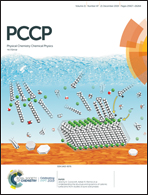Opening dynamics of HIV-1 gp120 upon receptor binding is dictated by a key hydrophobic core†
Abstract
HIV-1 entry is mediated firstly by the molecular recognition between the viral glycoprotein gp120 and its receptor CD4 on host T-cells. As a key antigen that can be targeted by neutralizing antibodies, gp120 has been a focus for extensive studies with efforts to understand its structural properties and conformational dynamics upon receptor binding. An atomistic-level revelation of gp120 opening dynamics activated by CD4, however, is still unknown. Here, by constructing a Markov State Model (MSM) based on hundreds of Molecular Dynamics (MD) simulations with an aggregated simulation time of ∼20 microseconds (μs), we identify the key metastable states of gp120 during its opening dynamics upon CD4 binding. The MSM provides a clear dynamic model whereby the identified metastable states coexist and can reach an equilibrium. More importantly, a hydrophobic core flanked by variable loops (V1V2 and V3) and the β20/21 region plays an essential role in triggering the gp120 opening. Any destabilizing effects introduced into the hydrophobic core, therefore, can be expected to promote transition of gp120 to an open state. Moreover, the variable loops demonstrate high flexibilities in fully open gp120. In particular, the V3 region is capable of exploring both closed and open conformations, even with the V1/V2 loops largely adopting an open form. In addition, the bridging sheet formation in gp120 is likely induced by the incoming co-receptor/antibody recognitions, since the V1/V2 structure is highly heterogeneous so that the bridging-sheet formed conformation is not the most populated state. Our studies provide deep insights into the dynamic features of gp120 and its molecular recognitions to the broadly neutralizing antibodies, which guides future attempts to design more effective gp120 immunogens.

- This article is part of the themed collection: 2019 PCCP HOT Articles


 Please wait while we load your content...
Please wait while we load your content...